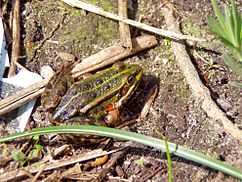Marsh frog
| Marsh frog | |
|---|---|
 | |
| A marsh frog on a white water-lily (Nymphaea alba) pad | |
| Conservation status | |
| Scientific classification | |
| Kingdom: | Animalia |
| Phylum: | Chordata |
| Subphylum: | Vertebrata |
| Class: | Amphibia |
| Order: | Anura |
| Family: | Ranidae |
| Genus: | Pelophylax |
| Species: | P. ridibundus |
| Binomial name | |
| Pelophylax ridibundus (Pallas, 1771) | |
| Synonyms | |
|
Rana ridibunda Pallas, 1771[2] | |
The marsh frog (Pelophylax ridibundus) is the largest frog native to Europe and belongs to the family of true frogs. It is very similar in appearance to the closely related edible frog and pool frog. These three species, now again in the genus Pelophylax, are often referred to as "green frogs" to distinguish them from the more terrestrial European Rana species, which are known as "brown frogs" (best exemplified by the common frog Rana temporaria).
Characteristics
The marsh frog is a water-dwelling, generally green-colored frog species. It can reach a maximum length of 17 centimetres, but males remain smaller (around 12 cm). The head is proportionally large and the hind legs are long, which gives them excellent jumping abilities.
There is a large variation in colour and pattern, ranging from dark green to brown or grey, sometimes with some lighter green lines; a lighter line on the back is generally present. The Western European populations are generally dark green to black with dark spots on the back and sides and three clear green lines on the back.
Diet
The diet of the marsh frog consists of dragonflies and other insects, spiders, earthworms and slugs. Larger frogs also eat small rodents and sometimes smaller amphibians and fish.
Distribution

The marsh frog occurs in the largest part of Europe, and in Asia east to ca. 81° E in Asiatic Russia, south to western Iran and Afghanistan, as well as isolated populations in Saudi Arabia.[2] They prefer a water temperature of approximately 15 °C.
It is now distinguished from Pelophylax kurtmuelleri (Balkan frog), which it resembles greatly, and which outnumbers it in most of Greece.
See also
- Edible frog
References
- ↑ Sergius Kuzmin, David Tarkhnishvili, Vladimir Ishchenko, Tatjana Dujsebayeva, Boris Tuniyev, Theodore Papenfuss, Trevor Beebee, Ismail H. Ugurtas, Max Sparreboom, Nasrullah Rastegar-Pouyani, Ahmad Mohammed Mousa Disi, Steven Anderson, Mathieu Denoël, Franco Andreone (2009). "Pelophylax ridibundus". IUCN Red List of Threatened Species. Version 2013.1. International Union for Conservation of Nature. Retrieved 24 July 2013.
- ↑ 2.0 2.1 Frost, Darrel R. (2013). "Pelophylax ridibundus (Pallas, 1771)". Amphibian Species of the World 5.6, an Online Reference. American Museum of Natural History. Retrieved 24 July 2013.
External links
Listen to Pelophylax ridibundus call sound
| Wikimedia Commons has media related to Pelophylax ridibundus. |
